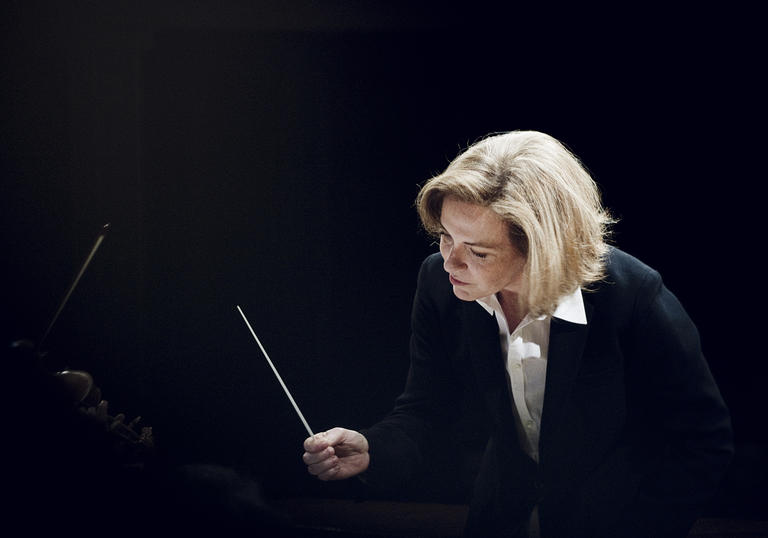
Programme and performers
Ludwig van Beethoven Fidelio (concert staging)
Insula orchestra
Laurence Equilbey conductor
Stanislas de Barbeyrac Florestan
Sinéad Campbell-Wallace Léonore
Sebastian Holecek Don Pizzaro
Christian Immler Rocco
Hélène Carpentier Marzelline
Anas Séguin Don Fernando
Patrick Grahl Jacquino
Lancelot Lamotte prisoner tenor
Matthieu Heim prisoner bass
accentus
David Bobée director
Nicolas Girard-Michelotti assistant director
Sabine Siegwalt costume designer
Beate Haeckl libretto revisions
Chloé Dufresne assistant conductor
Marc Korovitch choirmaster
Nicolaï Maslenko vocal coach
Johannes Koegel-Dorfs language coach
Synopsis
Act I
In eighteenth-century Spain, Leonore’s husband Florestan has been arrested and imprisoned by his villainous noble rival Don Pizzaro, for attempting to expose the latter’s crimes. Determined to rescue him, Leonore disguises herself as a boy, Fidelio, and takes a job at the prison where he is being held. Both the prison governor Rocco and his daughter Marzelline take a liking to ‘Fidelio’ causing problems for Leonore and for Jaquino, who loves Marzelline and is jealous of this new rival. ‘Fidelio’ works hard to gain Rocco’s trust, hoping that he will allow her to accompany him to the underground cell where her husband is imprisoned. She persuades Rocco to let the other prisoners out into the garden for a rare glimpse of sunlight. But when Pizarro discovers this he is furious, and orders them all immediately back to their cells.
Act II
On Pizzaro’s orders, Rocco has been slowly starving Florestan to death. But when Pizzaro hears that Don Fernando, a king’s minister, will visit shortly to investigate claims of Pizzaro’s cruelty, he vows to murder his captive. But just as Pizzaro is about to kill Florestan, ‘Fidelio’ throws himself between them. The stand-off is ended when a trumpet-call announces Don Fernando’s arrival: Florestan is saved, Pizarro led away to prison, and all sing the praises of brave Leonore.
Synopsis by Alexandra Coghlan, courtesy of Glyndebourne Productions Ltd.
Artist biographies
Insula orchestra’s purpose is very clear: to serve music from the baroque, classical and pre-romantic eras at the best of its abilities – that is, in a historically informed way. Side-by-side with masterpieces of the repertoire, the orchestra also features rarer pieces, such as the work of Louise Farrenc or Clara Schumann. The ensemble performs on period instruments to match as closely as possible the original sound, text and writing design.
With support of the Hauts-de-Seine department, Insula orchestra was founded in 2012 by its artistic director and conductor Laurence Equilbey. In 2017, it inaugurated the Seine Musicale venue as its resident orchestra. The orchestra is in charge of part of the Auditorium’s season, for which it invites numerous ensembles and artists. Insula orchestra also regularly performs in France and internationally in leading venues and festivals: Philharmonie de Paris, Grand Théâtre de Provence, Theater an der Wien, Stadtcasino in Basel, Elbphilharmonie of Hamburg, Barbican Centre in London and Louvre Abu Dhabi for its official inauguration.
The orchestra reinvents the formats and rules of classical music to reach out to all audiences. It regularly produces staged concerts to shine a new light on music, working with artists such as Yoann Bourgeois, Antonin Baudry, Pascale Ferran and David Bobée. It is particularly active on the field of digital technologies, and has delved into 360° experiences and virtual reality. A diversified and innovative education programme, striving towards sharing and inclusion, was developed throughout the Hauts-de-Seine department. In 2022, a new resource centre will be created to widely share its musical and scientific research, as well as the developed educational and digital resources: Insula Documenta.
Insula orchestra receives support from the Hauts-de-Seine department and is resident orchestra at the Seine Musicale. It is sponsored by Région Île-de-France. Mrs Aline Foriel-Destezet and Chargeurs are its great patrons. The circle of friends accio and the Insula orchestra – Laurence Equilbey foundation accompany its projects. Insula orchestra is a member of FEVIS and SPPF.
